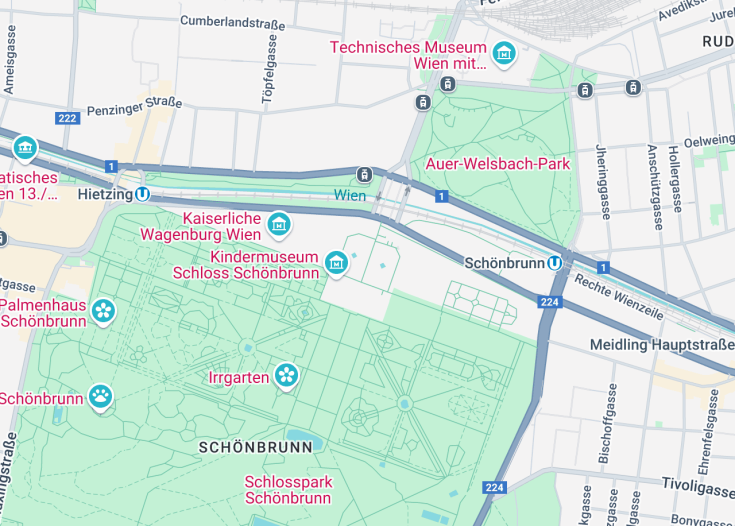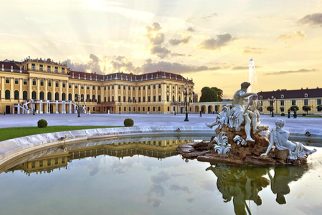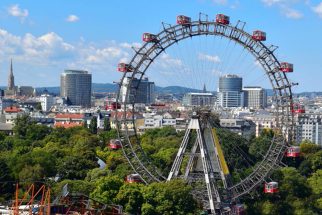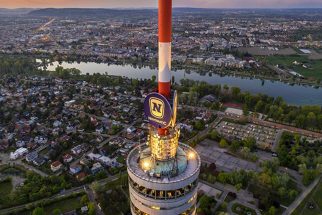Nestled in the heart of Vienna, Austria, Schönbrunn Palace stands as an enduring emblem of opulence and architectural grandeur. Originally built as a hunting lodge, this UNESCO World Heritage site has evolved through the centuries, showcasing styles from Rococo to Baroque. The palace was the main summer residence of the Habsburg rulers, which is evident in its elaborate design and expansive gardens. Visitors can explore the 1,441 rooms of historical importance and wander through the impeccably maintained grounds featuring the world-renowned Gloriette, the Neptune Fountain, and the Roman Ruins.
Arrive early to avoid the large crowds that Schönbrunn attracts daily, ensuring a more serene and immersed experience of its majestic architecture and gardens.
Purchase a combination ticket online to access various parts of the palace and its gardens, which also provides a detailed guide to enhance your visit.
Schönbrunn Palace: A gateway to imperial grandeur
Schönbrunn Palace, located in Vienna, Austria, stands as a magnificent witness to the country’s opulent past. Originally constructed as a hunting lodge, the palace evolved over the centuries into a grand summer residence for the Habsburg emperors. It is renowned for its beautiful architecture, expansive gardens, and rich cultural history. Tourists are drawn not only to its grandiose design but also to the glimpse it offers into the imperial lifestyle and the history of European aristocracy. The UNESCO World Heritage site includes an astounding 1,441 rooms, each bearing a unique testimony to the artistic and political influences that shaped Austria and Europe over centuries. The Palace’s gardens are a masterful display of Baroque landscape architecture and are perfect for leisurely strolls or formal guided tours, offering breathtaking views and a tranquil escape from the bustling city life of Vienna.
Exploring the historic and cultural significance of Schönbrunn
When visiting Schönbrunn Palace, there is much to see and do. The Imperial Tour takes visitors through 22 rooms where one can marvel at the decorative interiors that showcase the lavish lifestyle of the royalty. Highlights include the Great Gallery, with its intricate frescoes and elaborate ceiling paintings, and the Chinese Cabinets, which display the influence of Eastern aesthetics on Viennese art. For those interested in a deeper dive, the Grand Tour extends to 40 rooms. The palace also regularly hosts classical music concerts, embodying Vienna’s rich musical heritage.
Gardens and zoo
The Palace’s gardens are equally impressive, featuring the Gloriette monument, Roman ruins, and a zoo. The oldest existing zoo in the world, it provides a unique blend of historical architecture and wildlife conservation education.
The magic of the Schönbrunn Christmas Market
During the winter, the front of Schönbrunn Palace transforms into one of Vienna’s most enchanting Christmas markets. Visitors are treated to a magical atmosphere with twinkling lights and seasonal decorations enhancing the already stunning backdrop of the palace. Stalls offer a variety of traditional crafts, warm drinks, and Austrian delicacies, making it a perfect spot to gather with loved ones and celebrate the festive season amid a historical setting. This blend of history and festive spirit makes the Schönbrunn Christmas Market a must-visit during any trip to Vienna during the holidays.
Explore the elegant Schönbrunn Palace
The Schönbrunn Palace, often celebrated for its historical and architectural significance, is a must-visit destination for a variety of visitors. Ideal for families with children due to its interactive children’s museum, spacious gardens, and zoo, the palace also holds romantic appeal for couples with its intimate tours and scenic vistas. History buffs and architecture enthusiasts will appreciate the rich narratives and baroque artistry.
Visitors to Schönbrunn Palace are treated to a lavish experience of imperial Austria. Its meticulously preserved rooms are adorned with original decor that transports guests back to the days of Maria Theresa and Franz Joseph. Each corner of its expansive gardens invites leisurely walks or educational guided tours explaining the sophisticated designs and botanical details.
Additionally, the palace complex houses several cafes and a restaurant offering traditional Viennese cuisine, allowing visitors to relax and refuel while enjoying views of the historic surroundings.
The ideal season to visit Schönbrunn Palace
The best time to visit the Schönbrunn Palace is from April through October when the weather is most pleasant for exploring the gardens. Tourist peaks in July and August can be avoided by planning your visit in the shoulder months like April, May, and October.
Annual Easter Market
If you can time your visit around Easter, the Schönbrunn Easter Market offers unique crafts, performances, and local specialties, making it a special time to explore the palace and its traditions.
Accessibility and visitor limitations
Gaining access and understanding of any limitations at Schönbrunn is essential for a seamless visit.
Accessibility
Limitations
- No large bags or backpacks allowed inside the palace.
- Photography is restricted in some interior areas.
Notes to visitors
To ensure a comfortable visit, note the following:
- Appropriate footwear is recommended due to extensive walking.
- Most guided tours are available in multiple languages, but booking ahead is advisable.
- Visitor numbers might be subject to capacity limits during peak times.
General informations
Details for your visit to Schönbrunn Palace
Location
The palace is located near Hietzing underground station, making it easily accessible by public transport. Several bus stops and tram lines also serve the area.
Address:
Schönbrunner Schloßstraße 47, 1130 Wien, Austria
Opening hours
The palace gates are open from 8:00 AM to 5:30 PM daily, with extended hours until 6:30 PM during the summer months. Closed on major public holidays.
Traveling to Schönbrunn Palace
Visitors can easily reach Schönbrunn Palace from nearby cities or popular tourist accommodations using various modes of transportation.
By Car
Reach the palace conveniently by car. Ample parking is available, with designated areas for buses and coaches.
| Route | Distance | Travel time |
|---|---|---|
| From Vienna International Airport | 24 miles (38.6Km) | 30 minutes |
| From Vienna Central Station | 8 miles (12.8Km) | 20 minutes |
| From Vienna City Center | 5 miles (8Km) | 15 minutes |
By Public Transport
The most recommended transport to reach the palace is via the U4 green line of Vienna’s underground, which stops at Schönbrunn. Buses and trams available:
- Bus 10A from Vienna International Airport to Schönbrunn (approx. 45 minutes)
- Tram line 10 from Vienna Central Station to Schönbrunn (approx. 25 minutes)
Nearby Attractions
Explore other attractions close to Schönbrunn Palace:
- Zoo Vienna – 0.5 miles (0.8 km)
- Vienna Technical Museum – 1.5 miles (2.4 km)
- Belvedere Palace – 3 miles (4.8 km)
- Vienna State Opera – 4 miles (6.4 km)
- Albertina Museum – 4.2 miles (6.7 km)
- Hofburg Palace – 4 miles (6.5 km)
- Natural History Museum – 4.5 miles (7.2 km)
- St. Stephen’s Cathedral – 5 miles (8 km)
- Leopold Museum – 5 miles (8 km)
- Museum of Art History – 5 miles (8 km)
- Vienna City Hall – 4 miles (6.5 km)
- Burgtheater – 4.5 miles (7.2 km)
Common questions
What historical significance does Schönbrunn Palace hold?
Are there guided tours available at Schönbrunn Palace?
Can you visit the gardens of Schönbrunn Palace?
What architectural style is Schönbrunn Palace built in?
What are some must-see parts of Schönbrunn Palace?
What unique artifacts or artworks are housed in Schönbrunn Palace?
Is there a dress code for entering Schönbrunn Palace?
Are there any restrictions on photography within the palace?
Can I host an event at Schönbrunn Palace?
What are some conservation efforts implemented at Schönbrunn Palace?
What educational programs are available for children at Schönbrunn Palace?
Are pets allowed in the gardens or palace of Schönbrunn?

Is the schönbrunn palace in vienna worth visiting?
Visiting the Schönbrunn Palace offers a unique glimpse into the lavish lifestyles of Austria’s imperial past. Tourists can explore historically rich rooms where monarchs once roamed and marvel at the intricate Baroque architecture. One of the highlight features is its expansive gardens, perfect for leisurely strolls. However, it’s worth noting that the palace can be quite crowded during peak tourist seasons, which can somewhat diminish the experience. If you prefer a quieter, more reflective historic visit, you might want to consider visiting other lesser-known but equally enchanting sites nearby. For those fascinated by history and architecture, though, the Schönbrunn Palace is definitely worth a visit, offering a profound cultural insight into Vienna’s royal history.















